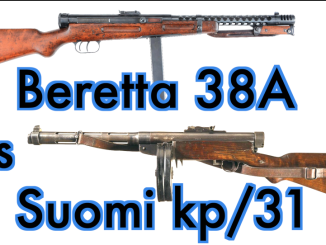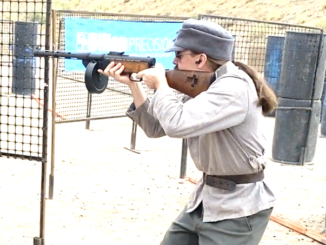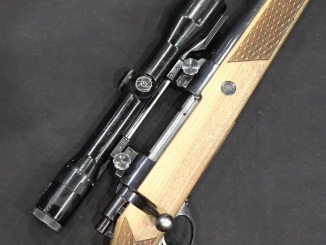The kp/31 Suomi submachine gun in Finnish service was an outstanding weapon, but it was slow and expensive to manufacture. When Finnish forces began capturing Soviet PPS-42 and PPS-43 submachine guns form the Soviets in the Continuation War, it was very quickly decided that Finland should copy the design. This was a far simpler, far cheaper stamped sheet metal design that was not as refined as the Suomi, but much more efficient to make.
The Sudayev design was changed only minimally; primarily to fit the Finnish cartridge (9x19mm Parabellum) and magazines. They guns were originally designed to use the 50-round quad-stack boxes and 71/72 round drums of the Suomi, but also used the Swedish Carl Gustaf m/45 magazine that was adopted by Finland after WW2.
Two companies were approached to produce the M44; Tikkakoski and Ammus Oy. Ammus was unable to source raw materials for the project, and only Tikka put the guns into production. Marshal Mannerheim initially wanted 50,000, but the order was reduced to 20,000 – of which only 10,000 were actually made, due to limited material availability before the end of the war led to production ending. Another 400 were assembled from remaining parts after the war.
In the 1950s, a plan was begun to resume M44 production in order to completely replace the Suomi in Finnish inventory. However, this plan was interrupted when Sam Cummings of InterArms made a deal to trade Finland about 75,000 surplus Sten guns for Finland’s supply of 7.35mm Carcano rifle (received as aid form Italy during the war) along with a melange of old machine guns. This was a sufficient quantity of Stens to handle the duties of the Suomi, and so the Sten went into Finnish service and M44 production was never resumed.
Those Carcano rifles were in turn imported into the United States, and this is why the majority of 7.35mm Carcano here bear Finnish “SA” property stamps. The same is true for the significant number of Chauchat automatic rifles in the US with Finnish property marks, which were also part of the deal.




Lord help us if we enter into war again now. We won’t even be able to get plywood!
Just a reference to Ammus Oy having trouble getting raw material.
Haven’t you heard? We’re a service economy now – we’ll all get rich selling hamburgers to each other. As far as military weapons go, not to worry, China will make as many as we want for a far lower price than domestic sources. Those Uyghurs work for pennies!
Exactly!
The narrow-eyed will provide you with everything! LOL
https://www.nytimes.com/2021/04/23/business/auto-semiconductors-general-motors-mercedes.html
How about the narrow minded?
Well said.
I was lucky enough to meet Sam Cummings on a couple of occasions, and he was a very friendly gentleman. My question now would be where did he find 75,000 Sten guns?
I never knew that Interarms was big enough to stem such massive trades. Interesting!
Most likely Canada. Sten Mk IIs with the “outline” stock rather than the single-strut type were mostly manufactured by Canadian Car & Foundry.
After 1945, the Canadian Army adopted the Sterling (Patchett) SMG, along with the British Army. It was also manufactured in Canada.
So there were likely a large number of Canadian-made Sten guns in store that the Canadian government would have been only too happy to get off the books- and out of the country.
cheers
eon
Very many of the Stens that went to Finland were Mk.IIIs. These were all made at the Lines Bros. Tri-ang sheet-metal toy factory in the UK.
The problem with the Mk.III was that the barrel was permanently installed to the receiver, unlike the Sten Mk.II attached with a barrel nut. So if something happened to the receiver, you disposed of the entire gun, and if something went awry with the barrel, you disposed of the entire gun… Basically a quasi-disposal SMG!
https://en.wikipedia.org/wiki/Lines_Bros
Dave,
Tri-ang sound like just the people to have made the ultimate simplified Sten gun. Remember their sheet metal toys?
The Canadian Sten guns were a cut above the rest. I had the chance to shoot one once, and they seemed better made than the British guns, with a better finish, and the skeleton stock was comfortable to use compared to the strut and triangle design. If I had been a Finnish squaddie I wouldn’t have minded a Canadian Sten Mk II, a Tri-ang Sten Mk III, less so.
A quad-stack magazine sounds worthy of its own video. How were they to load?
“(…)quad-stack magazine(…)”
For details of working of said magazine see U.S. Patent 2,217,848 CARTRIDGE CASE FOR FIREARMS
https://patents.google.com/patent/US2217848
Sako translated stands for “The Weapons Repair Depot of the Civic Guard”, btw.
SA is simply a short for “Suomen Armeija”, ie the Finnish Army.
Thought the beep at the grip mention was my smoke detector, but it’s in this video…
Actually, it was the end of the Continuation War that put an abrupt end to the KP/-44 story. In September 1944 Finland, Bulgaria and Romania changed sides of the war to the Allies. The Finns didn’t have a choice – they were made to choose between that and full-bore Soviet assault and subsequent occupation – the Baltic States scenario, nothing to envy. Fortunately for them, Finnland was aside from the main corridor Stalin was then going full-bore for Western Europe, so he was in the mood for talking to avoid side-skirmishes with people who already once proved they quite capable of putting tough resistance. One of the conditions was handing over of all German-owned industry, and that included Tikkakoski Oy, which was the property of a German, Willi Daugs, who fled to Spain (the Dux story Ian hinted on). They took over the factory compound in 1944, making sure no more guns were made there for the Finnish Army – and that included the initial batch of 10K KP-44s, still not delivered. The Finnish Army only got these in 1954, when the Soviets finally withdrew from parts of Finnland they occupied after WW2. After they gone, the Finns were astonished to having found intact crates with 10 000 KP-44s, several thousand KP-31 in various states of completion plus lots of spares. The Soviets had enough guns of their own, so these were just left alone in underground AA shelters on site! In 1955 a decisions was made to assemble what was found, and that were all the guns that finally made it to the Army. Then, already in 1956, the Finns decided to re-arm with AKs – and BTW, they imported the samples from Poland, not from Soviet Union. Then SAKO (Suojeluskunta Ase- ja Konepaja, Oy = Civic Guard’s Arms- and Machine Shops, Ltd) copied the milled-receiver AK, which resulted in the Rk-58 and Rk-60 prototypes and then series-production Rk-62 (which in its way became a model for Galil later on). The Interarms Stens were intended as mobilization stores from the beginning, even though some were actually used for service: as Ian remarked, although Suomi, which was then a main SMG in the Army (and remained so until withdrawn in 1996) was a wonderful weapon for shooting – hauling it on one’s back for days on end was a killjoy, indeed. Stens were lighter, and so were the KP-44s.
And yes, the 44s were Finnland’s “export” weapon, meaning the gun for the Finnish United Nations troops, the FINBAT, in Sinai in 1956, then on Cyprus and Lebanon in the 1960s and 70s. In 1956 the first FINBAT was all armed with KP-44s, as Suomis were feared to make Finns look obsolete! In Cyprus they were already re-armed with Rk-62s (Kalashnikovs), with one KP-44 per squad (NCO’s weapon), and given to drivers, cooks, commsmen and other non-combat troops.
Almost correct, but not quite. The only area occupied in Finland aside those ceded in Moscow and Paris peace treaties (which were the same as after Winter War plus the Petsamo/Pechenga area in extreme northeast) was the Porkkala area, which was actually rented but not ceded. The original rental period was 50 years, but in 1956 the Soviets agreed to return it as a sign of improved relations and also because development of arms technology had made the Porkkala base obsolescent.
The Tikkakoski factory was never occopied by the Soviets, although it was inspected by the Allied Control Commission (which had British members but was controlled by the Soviets) after the production of the M/44 had already finished. That said, most of the guns were actually manufactured after the armistice with the Soviets. The Soviets could not magically transport men to locales in Finland, which was still an independent country, and the Allied Control Commission had a personnel of a few hundred, so they could not be everywhere at once. Mostly they concentrated on major military and political issues and not on manufacturing of individual weapons.
The actual guns entered Finnish Army inventory in 1945 immediately after manufacturing, and certainly not in 1956, as your version would have it. In 1951 additional 398 guns was assembled from parts. The Allied Control Commission left the country in 1947, after which there were no restrictions on domestic weapons manufacturing, apart from those dictated by the Paris peace treaty, which had no restrictions for small arms.
Kiitos for the details!
Somewhat heretically, allow me to state that contra “Best SMG of WWII: The Beretta M38A” I would include industrial efficiency into the considerations aside from user-friendliness, accuracy, etc. and hand the award to the Soviet PPS-43?!
Always interested in Peltiheikki!
One might be surprised that PPS-43 stayed in production for so long. Due to their dire situation, the Russians would pick one weapon and devote all their energies into producing it. So how did the PPS-43 survive against the PPSh-41? The folding stock. Its handiness made it the preferred weapon for AFV crews and motorized infantry
In this instance, the PPS Sudayev was developed in besieged Leningrad. After the siege was broken, the Sudayev commended itself for the reasons you list, namely, the folding stock. There were field trials of a fixed-stock version, which as you know, was how the gun was manufactured in post-war Poland. There were similar independent SMG designs in instances like Tula, when it formed a salient in the front during Unternehmen Taifun. Those ad-hoc SMGs were eliminated in favor of the Shpagin PPSh-41 later.
https://modernfirearms.net/en/submachine-guns/russia-submachine-guns/korovin-1941-eng/
This gun was never officially tested or approved – all specimens went from the workbenches of the factory straight into combat, carried by volunteers of the Tula arms factory regiment, fighting the Nazi invaders at the outskirts of the Tula city.
The Korovin looks like a very nice gun. The grip in particular looks very comfortable. Frankly, it looks like a better gun than the Sten, despite being produced under desperate circumstances.
“Those Uyghurs work for pennies!”
In case anyone doesn’t catch the sarcasm, the Uyghurs are being used as slave labor by the Han Chinese.
China has more then enough of their own population working in slave like conditions in many factories, they certainly do not need anybody else.
So this “sarcasm” and its forced explanation (when realising its not picked up as a talking point) has only a hidden propaganda/defamation value.
Regardless of your point,the simple fact is China uses slave labor. There is no justification possible.
Seems that it does not bother worlds capitalists, as today almost all of the goods are produced there.
It does not bother chinese too, as billion of people have something to do, so its a supply and demand relationship.
But it certainly should bother western economies when one day they found themselves without vital production items outsourced to China, that now starts blackmailing with their selling. This chip crisis of last year (and now) is best example.
Eon I wonder how many stens Canada actually had made/stockpiled I ask this because after the Quebec crisis in 1971 Blake Stevans later editor of Collector Grade Publications was selling mk 11 sten parts kits for 100cnd that had had the chamber and bolt torched by the canadian army
These were were said to come out of Quebec arsenals and had been destroyed along with some old model BARS in order to prevent les sepratists from getinng their hands on them
It looks like the charging handle was added to the bolt after the bolt was turned in a lathe.
Yeah, it makes no sense it was machined from a solid piece to the point that only charging handle sticks out, that would be incredibly wasteful
I pains me that I can’t recall the reference, but I have read that the -43 required around 13lb of steel and 2.3 man hours (in a factory equipped with massive hydraulic presses of course) to produce whereas the -41 needed almost 30lb of raw materials and close to 5 man hours to produce a gun of similar weight. I cannot imagine a more efficient design has ever been conceived.
As an aside, I think this fact well illustrates the ATF’s folly with their “readily convertible into a machinegun” standard of “one day in a machine shop” that they’ve espoused in court when there are numerous designs that can be built from scratch in less time than it takes to watch an American football game.
According to https://warspot.ru/4083-dolgaya-doroga-korotkogo-pps
recommendation for production for PPS has following phrase
значительную экономичность ППС в производстве по сравнению с ПП-41. ППС почти в два раза менее трудоёмок, и на изготовление его требуется на 30% меньше металла.
i.e. significantly economics PPS in production compared with PP-41 [PPSh]. PPS requires almost 2 times less effort, and 30% less metal is required.
“(…)cannot imagine a more efficient design has ever been conceived.”
There was one, it was competitor to PPS generally known as PPSh-2
общее время на изготовление ППС в часах равно 4,23, тогда как ППШ-2 – 3,8
total time required for crafting PPS is equal 4,23 hour, meanwhile for PPSh-2 it is 3,8 hour
(note: machine-hours pertains to machine working only, total include also other actions done by workers)
https://modernfirearms.net/en/submachine-guns/russia-submachine-guns/ppsh-2-eng/
It’s a fool’s game to even try preventing technology by banning it. You want to keep machine guns out of the hands of the populace, the only real way to do it is to ensure that they don’t feel the need to have such things… And, you do that through good governance alone, because banning the technology isn’t gonna do it. There is no history of successfully stopping a technology through rule-making; Japan’s experience with “giving up the gun” isn’t a factor, because that was more down to Japan’s inherent social conformity than anything else. Were you to try a similar sort of “sword hunt” mentality in most other cultures, your success rate would have been a hell of a lot lower. Ask the British how well it went, trying to suppress weapons in North America… I think there was an incident at a place called Concord? Something like that…
It’s only going to get worse. CRISPR technology is eventually going to reach a point where you’re going to be able to craft up disease organisms with an automated ease that’s likely going to make the current COVID pandemic look like a mere trial run for hell on earth. Next to that, firearms technology looks a sad joke–When you can run up biological warfare agents in the average high school instructional laboratory…? What then?
Personally, I think we’re gonna be lucky to survive, as a species–It’s just getting too damn easy to make these things. People forget just how lethal a lot of modern industry and science can be, given the wrong actors involving themselves. I mean, when you look at the potential for damage, a fully-automatic range toy pales in comparison to what someone could do in an industrial setting with access to the right materials, the right knowledge, and an utter disregard for human life.
I mean, why bother with taking a gun into work and offing your long-hated boss and co-workers, when you could just as easily go in with a wrench, turn a few valves and bypass safety protocols, and take half the city with you? Having studied a lot of industrial safety materials, over the years? You’d be shocked at how easily that could be done, and how many industries have that sort of power.
Hell, look at some of the industrial accidents we’ve seen, even with relatively benign industries like hydropower; you don’t think of that sort of industry as having the potential, but… Look at the details of what went wrong at Sayano-Shushenskaya, in Siberia. That sort of thing is far more possible than anyone wants to admit, as a potential example of industrial-scale sabotage from within. Friend of mine is a dam operator here on the Columbia, and his opinion is that it’d be possible for something like what happened there to happen on his dam, with the right conditions, and in a very short period of time–All it would take is for someone with the right sick bent of mind to be running the dam’s penstocks, surging the water flow, and you’d see something very similar to what happened there.
You can’t stop bad things from happening by banning technologies; you can only stop those things by working on the minds of the users such that they don’t want to abuse the technology. And, by policing the abuses when they happen, not allowing them to get out of hand.
I’m pretty sure a modern machine shop could be churning out STEN weapons or their equivalent with about a morning’s worth of effort. Magazines and ammo might take a little longer, but… It is possible. Which means that banning the damn things is really impossible, if enough people really want them and feel the need.